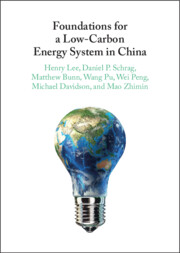Book contents
- Foundations for a Low-Carbon Energy System in China
- Foundations for a Low-Carbon Energy System in China
- Copyright page
- Contents
- Acknowledgments
- 1 Introduction
- 2 Reforming China’s Electricity Market to Facilitate Low-Carbon Transition
- 3 Promoting Large-Scale Deployment and Integration of Renewable Electricity
- 4 Enabling a Significant Nuclear Role in China’s Decarbonization
- 5 Transitioning to Electric Vehicles
- 6 From Barrier to Bridge
- 7 Coordinating Strategies to Reduce Air Pollution and Carbon Emissions in China
- 8 Conclusion
- Index
- References
7 - Coordinating Strategies to Reduce Air Pollution and Carbon Emissions in China
Published online by Cambridge University Press: 02 December 2021
- Foundations for a Low-Carbon Energy System in China
- Foundations for a Low-Carbon Energy System in China
- Copyright page
- Contents
- Acknowledgments
- 1 Introduction
- 2 Reforming China’s Electricity Market to Facilitate Low-Carbon Transition
- 3 Promoting Large-Scale Deployment and Integration of Renewable Electricity
- 4 Enabling a Significant Nuclear Role in China’s Decarbonization
- 5 Transitioning to Electric Vehicles
- 6 From Barrier to Bridge
- 7 Coordinating Strategies to Reduce Air Pollution and Carbon Emissions in China
- 8 Conclusion
- Index
- References
Summary
The heavy reliance on coal for energy contributes to both air pollutants and CO2 emissions in China. As air pollution control becomes one of the top government priorities in recent years, many measures to tackle air pollution, such as curbing coal consumption, increasing energy efficiency, and encouraging renewable energy investments, can simultaneously reduce carbon emissions. However, air pollution abatement measures are not always aligned with carbon mitigation goals. For instance, installing sulfur scrubbers on coal power plants can significantly reduce air pollutant emissions, but does not mitigate carbon emissions. Given the political saliency of air pollution concerns, it is critical for policymakers to understand the potential synergies and trade-offs between these two objectives: improving air quality and protecting human health in the near term, and achieving deep decarbonization to tackle climate change in the long term.
- Type
- Chapter
- Information
- Foundations for a Low-Carbon Energy System in China , pp. 157 - 167Publisher: Cambridge University PressPrint publication year: 2021



